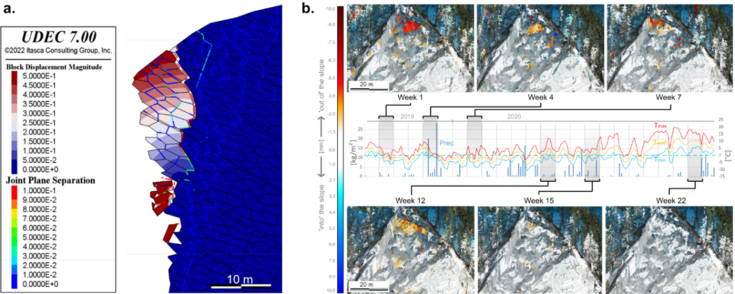The Role of Brittle Rock Mass Fracturing in Rock Slope Instabilities
SUPERVISOR: Christian ZANGERL
PROJECT ASSIGNED TO: Reinhard GERSTNER
Rock slope failure imposes a common hazard in mountain regions, affecting infrastructure and human lives. Many studies have shown that the reactivation of pre-existing geological structures, such as faults, joints or shear bands, is a crucial factor influencing rock slope failure (Agliardi et al. 2013; Stead and Wolter 2015; Rechberger et al. 2021). In addition to this exploitation of geological structures, progressive rock mass fracturing processes have gained increasing attention in the landslide and rock mechanic community (Einstein et al. 1983; Elmo et al. 2018). As these processes are difficult to detect and measure, they impose a substantial challenge in rock slope engineering and continue to be the subject of ongoing research (Donati et al. 2023).
In my dissertation, I am investigating the combined influence of geologic structures and brittle fracture processes on the mechanics of slope instabilities. To this end, I selected four case studies in the European Alps. They exhibit different failure mechanisms and volumes ranging from 30,000 to several million m3 (Figure 1).

Figure 1 The case studies and their location within Austria (DGM source: https://www.data.gv.at/katalog/dataset/land-ktn_digitales-gelandemodell-dgm-osterreich)
For all case studies, I perform geological field surveys comprising geological mapping, structural characterisation, and the quantification of the discontinuity network (Figure 2a). Together with rock mechanic testing and mineralogical analysis, a comprehensive rock mass characterisation for each study site is conducted. Thereby, I form the basis for numerical investigations using the distinct element modelling code UDEC (Itasca 2018). In these numerical investigations, I apply a synthetic rock mass approach based on the Voronoi logic(Spreafico et al. 2017) (e.g. Spreafico et al. 2017), i.e. the asymmetric Voronoi technique (Gerstner et al. 2023). By this technique, I model a highly schistose, heavily foliated, fractured metamorphic rock mass (Figure 2b). The application of several remote sensing techniques, namely multitemporal terrestrial laser-scanning, ground- and satellite-based interferometric synthetic aperture radar, and unmanned aerial vehicle photogrammetry, allow the validation of the model results (Figure 2c).

Figure 2 Excerpt of the applied methods a. Geological field surveys; b. The asymmetric Voronoi approach; c. Remote sensing techniques, i.e. terrestrial laser scanning with a Riegl VZ4000 and ground-based interferometric synthetic aperture radar (Ellegi-LiSALab™)
The results from the first case study in Hüttschlag (Salzburg, Austria) using this integrated methodical approach demonstrate that the toppling mechanism of rock slope failure was controlled by both pre-existing geological structures and brittle rock mass fracturing (Figure 3a). The results were validated by advanced remote sensing techniques, e.g. ground-based interferometric synthetic aperture radar (Figure 3b). Furthermore, the results from the Wasserradkopf show that a complex step-path failure can be modelled by this asymmetric Voronoi logic, which is in great agreement with the field observations. Thereby, my dissertation contributes to a better assessment of rock slope stability in complex geological media. Furthermore, our mechanical understanding of rock slope failures in different settings, from settlement areas to the periglacial environments and with variable failure volumes and mechanisms, is improved.

Figure 3 Selected results. a. Results from the asymmetric Voronoi approach and the b. validation by remote sensing, here by ground-based interferometric synthetic aperture radar
References
Agliardi F, Crosta GB, Meloni F, Valle C, Rivolta C. (2013). Structurally-controlled instability, damage and slope failure in a porphyry rock mass. Tectonophysics, 605, 34-47. https://doi.org/10.1016/j.tecto.2013.05.033
Donati D, Stead D, Borgatti L. (2023). The Importance of Rock Mass Damage in the Kinematics of Landslides. Geosciences, 13(2), 52. https://doi.org/10.3390/geosciences13020052
Einstein HH, Veneziano D, Baecher GB, O'Reilly KJ. (1983). The effect of discontinuity persistence on rock slope stability. International Journal of Rock Mechanics and Mining Sciences & Geomechanics Abstracts, 20(5), 227-236. https://doi.org/10.1016/0148-9062(83)90003-7
Elmo D, Donati D, Stead D. (2018). Challenges in the characterisation of intact rock bridges in rock slopes. Engineering Geology, 245, 81-96. https://doi.org/10.1016/j.enggeo.2018.06.014
Gerstner R, Fey C, Kuschel E, Valentin G, Voit K, Zangerl C. (2023). Polyphase rock slope failure controlled by pre-existing geological structures and rock bridges. Bulletin of Engineering Geology and the Environment, 82(9), 363. https://doi.org/10.1007/s10064-023-03382-2
Itasca. (2018). UDEC—Universal distinct element code, Version 7.0, User’s Manual. In (Version 7.0) Itasca Consulting Group.
Rechberger C, Fey C, Zangerl C. (2021). Structural characterisation, internal deformation, and kinematics of an active deep-seated rock slide in a valley glacier retreat area. Engineering Geology, 286. https://doi.org/10.1016/j.enggeo.2021.106048
Spreafico MC, Cervi F, Francioni M, Stead D, Borgatti L. (2017). An investigation into the development of toppling at the edge of fractured rock plateaux using a numerical modelling approach. Geomorphology, 288, 83-98. https://doi.org/10.1016/j.geomorph.2017.03.023
Stead D, Wolter A. (2015). A critical review of rock slope failure mechanisms: The importance of structural geology. Journal of Structural Geology, 74, 1-23. https://doi.org/10.1016/j.jsg.2015.02.002
